牛津译林版(2019)必修 第三册Unit 1 Nature in the balance Welcome to the unit & Reading 课件(共15张PPT)
文档属性
| 名称 | 牛津译林版(2019)必修 第三册Unit 1 Nature in the balance Welcome to the unit & Reading 课件(共15张PPT) | 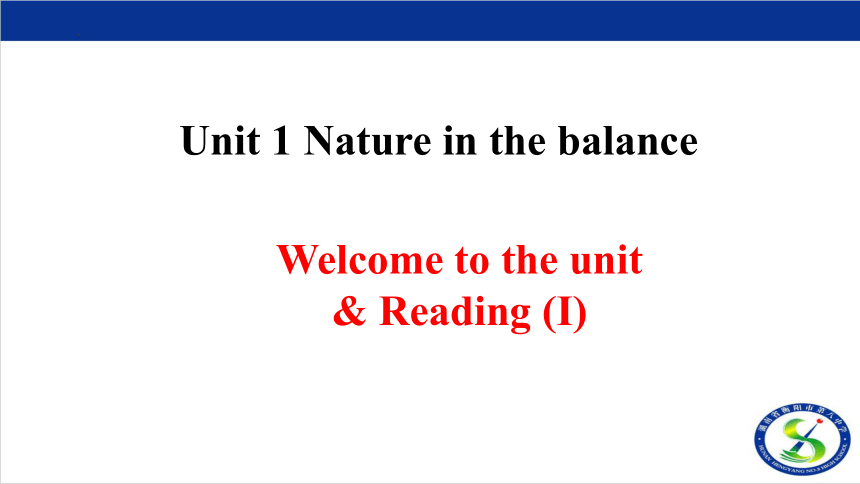 | |
| 格式 | pptx | ||
| 文件大小 | 2.6MB | ||
| 资源类型 | 教案 | ||
| 版本资源 | 牛津译林版(2019) | ||
| 科目 | 英语 | ||
| 更新时间 | 2023-07-13 20:36:33 | ||
图片预览


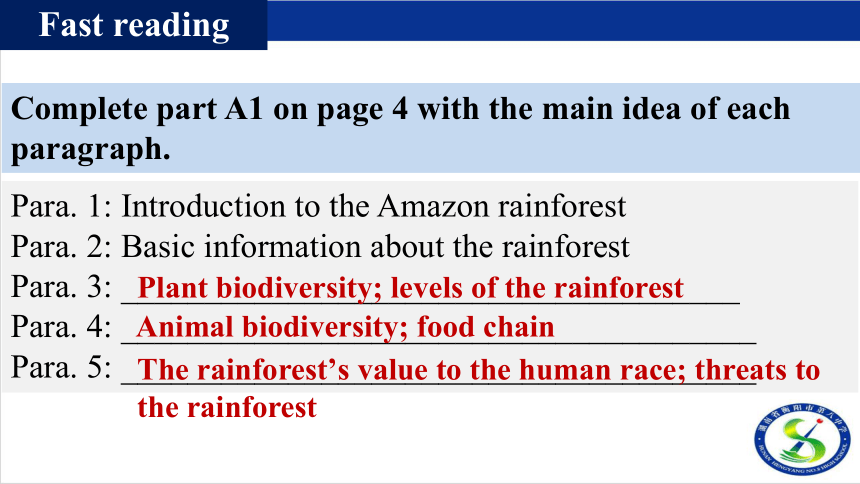
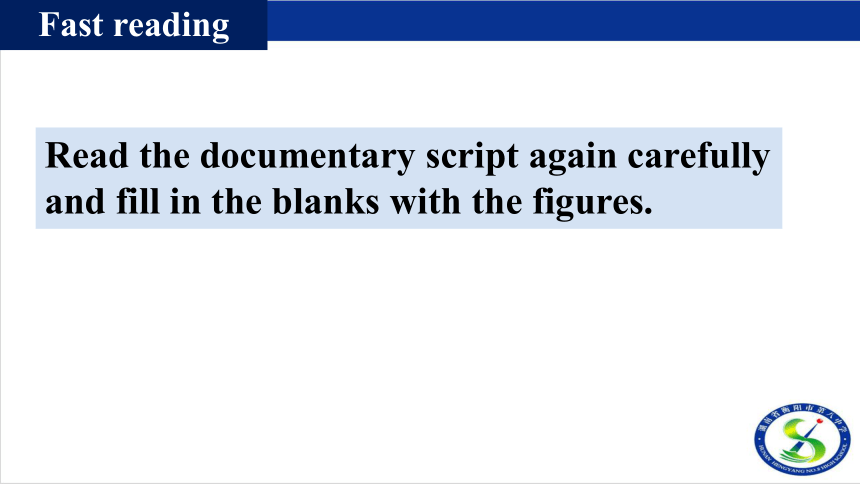
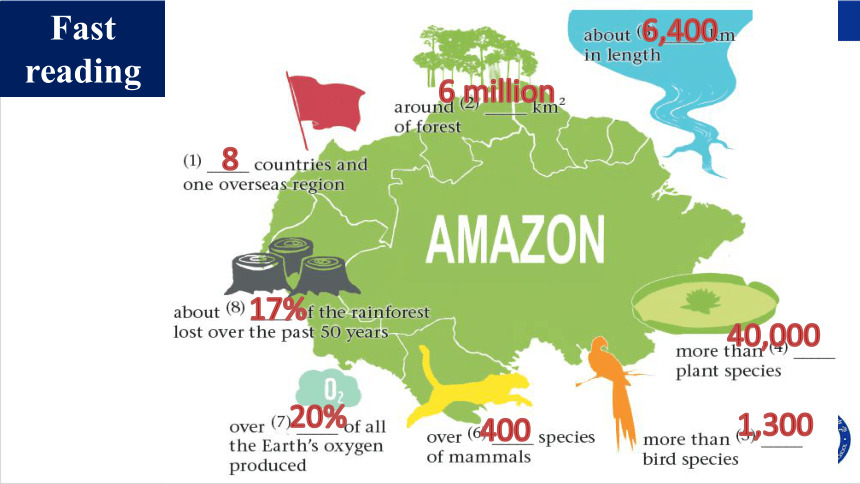
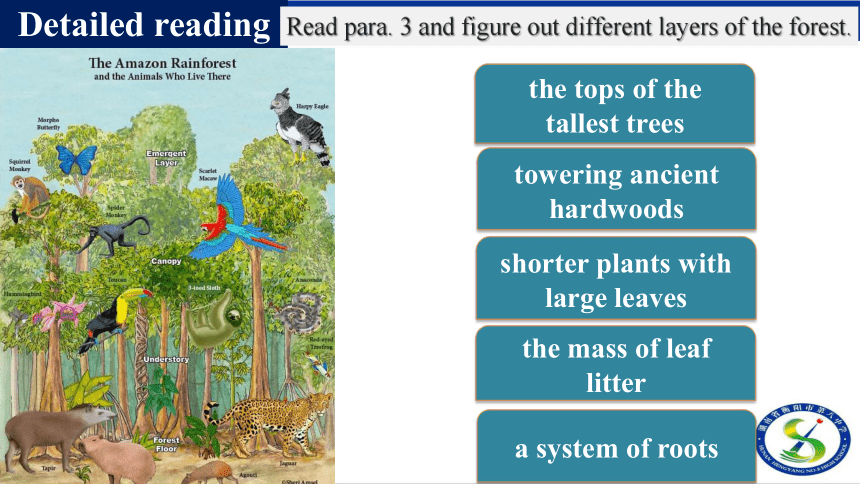
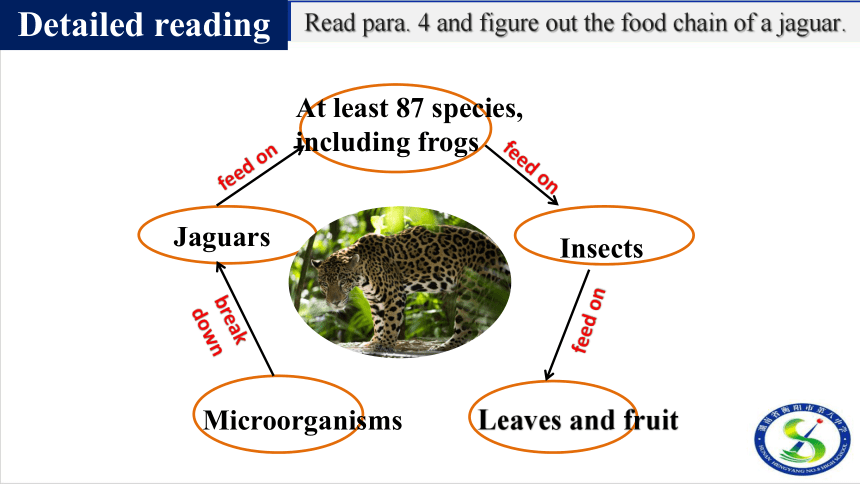
文档简介
(共15张PPT)
Welcome to the unit
& Reading (I)
Unit 1 Nature in the balance
Pre-reading
What plants or animals do you know about What is special about them
The cheetah is a large cat native to Africa and central Iran. It is the fastest land animal, estimated to be capable of running at 80 to 128 km/h (50 to 80 mph) with the fastest reliably recorded speeds being 93 and 98 km/h (58 and 61 mph), and as such has several adaptations for speed, including a light build, long thin legs and a long tail.
The cheetah is active mainly during the day and hunting is its major preoccupation, with peaks during dawn and dusk. It feeds on small- to medium-sized prey.
Para. 1: Introduction to the Amazon rainforest
Para. 2: Basic information about the rainforest
Para. 3: _____________________________________
Para. 4: ______________________________________
Para. 5: ______________________________________
Plant biodiversity; levels of the rainforest
Animal biodiversity; food chain
The rainforest’s value to the human race; threats to the rainforest
Complete part A1 on page 4 with the main idea of each paragraph.
Fast reading
Fast reading
Read the documentary script again carefully and fill in the blanks with the figures.
Fast
reading
6,400
6 million
8
17%
20%
400
40,000
1,300
Detailed reading
Read para. 3 and figure out different layers of the forest.
a system of roots
the mass of leaf litter
shorter plants with large leaves
towering ancient hardwoods
the tops of the
tallest trees
Jaguars
Insects
At least 87 species, including frogs
Leaves and fruit
Microorganisms
feed on
break down
feed on
feed on
Detailed reading
Read para. 4 and figure out the food chain of a jaguar.
Detailed reading
Watch a video on tropical rainforest ecosystem.
Retell the information about the Amazon forest.
In-depth reading
The Amazon is on fire!
In-depth reading
The Amazon is on fire!
In-depth reading
In-depth reading
What year will the Amazon rainforest be gone
A recent study suggests that 21-43 percent of the Amazon's original extent will be lost by 2050 , putting it close to, or beyond, the tipping point for a biome(生物群落) shift in large parts of the region.
In addition to the carbon release associated with deforestation, NASA has estimated that if deforestation levels proceed, the remaining world's forests will disappear in about 100 years.
In-depth reading
What can we do to help maintain a delicate ecological balance
Reduce, reuse, and recycle. Cut down on what you throw away. Follow the three "R's" to conserve natural resources and landfill space.
Shop wisely. Buy less plastic and bring a reusable shopping bag.
Use long-lasting light bulbs. Energy efficient light bulbs reduce greenhouse gas emissions. Also flip the light switch off when you leave the room!
Plant a tree. Trees provide food and oxygen. They help save energy, clean the air, and help combat climate change.
Bike more. Drive less.
…
Homework
1. Exercises B1 & B2, Page 5;
2. Introduce places in China with rich biodiversity like the Amazon rainforest.
Welcome to the unit
& Reading (I)
Unit 1 Nature in the balance
Pre-reading
What plants or animals do you know about What is special about them
The cheetah is a large cat native to Africa and central Iran. It is the fastest land animal, estimated to be capable of running at 80 to 128 km/h (50 to 80 mph) with the fastest reliably recorded speeds being 93 and 98 km/h (58 and 61 mph), and as such has several adaptations for speed, including a light build, long thin legs and a long tail.
The cheetah is active mainly during the day and hunting is its major preoccupation, with peaks during dawn and dusk. It feeds on small- to medium-sized prey.
Para. 1: Introduction to the Amazon rainforest
Para. 2: Basic information about the rainforest
Para. 3: _____________________________________
Para. 4: ______________________________________
Para. 5: ______________________________________
Plant biodiversity; levels of the rainforest
Animal biodiversity; food chain
The rainforest’s value to the human race; threats to the rainforest
Complete part A1 on page 4 with the main idea of each paragraph.
Fast reading
Fast reading
Read the documentary script again carefully and fill in the blanks with the figures.
Fast
reading
6,400
6 million
8
17%
20%
400
40,000
1,300
Detailed reading
Read para. 3 and figure out different layers of the forest.
a system of roots
the mass of leaf litter
shorter plants with large leaves
towering ancient hardwoods
the tops of the
tallest trees
Jaguars
Insects
At least 87 species, including frogs
Leaves and fruit
Microorganisms
feed on
break down
feed on
feed on
Detailed reading
Read para. 4 and figure out the food chain of a jaguar.
Detailed reading
Watch a video on tropical rainforest ecosystem.
Retell the information about the Amazon forest.
In-depth reading
The Amazon is on fire!
In-depth reading
The Amazon is on fire!
In-depth reading
In-depth reading
What year will the Amazon rainforest be gone
A recent study suggests that 21-43 percent of the Amazon's original extent will be lost by 2050 , putting it close to, or beyond, the tipping point for a biome(生物群落) shift in large parts of the region.
In addition to the carbon release associated with deforestation, NASA has estimated that if deforestation levels proceed, the remaining world's forests will disappear in about 100 years.
In-depth reading
What can we do to help maintain a delicate ecological balance
Reduce, reuse, and recycle. Cut down on what you throw away. Follow the three "R's" to conserve natural resources and landfill space.
Shop wisely. Buy less plastic and bring a reusable shopping bag.
Use long-lasting light bulbs. Energy efficient light bulbs reduce greenhouse gas emissions. Also flip the light switch off when you leave the room!
Plant a tree. Trees provide food and oxygen. They help save energy, clean the air, and help combat climate change.
Bike more. Drive less.
…
Homework
1. Exercises B1 & B2, Page 5;
2. Introduce places in China with rich biodiversity like the Amazon rainforest.
同课章节目录
- Unit 1 Nature in the balance
- Welcome to the unit
- Reading
- Grammar and usage
- Integrated skills
- Extended reading
- Project
- Unit 2 Natural disasters
- Welcome to the unit
- Reading
- Grammar and usage
- Integrated skills
- Extended reading
- Project
- Unit 3 The world online
- Welcome to the unit
- Reading
- Grammar and usage
- Integrated skills
- Extended reading
- Project
- Unit 4 Scientists who changed the world
- Welcome to the unit
- Reading
- Grammar and usage
- Integrated skills
- Extended reading
- Project
